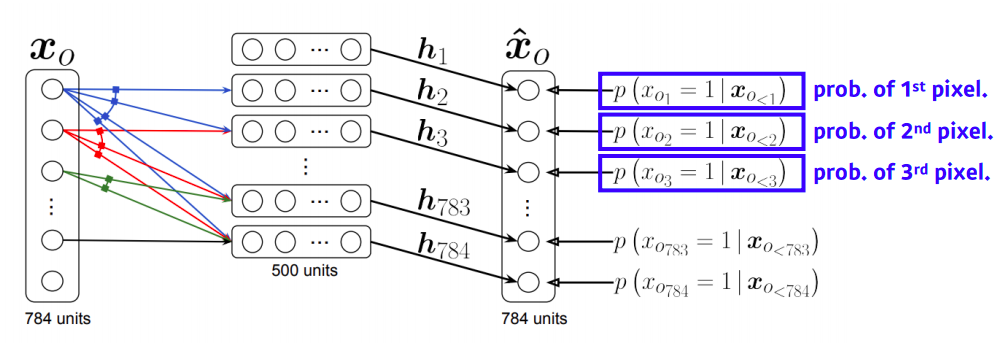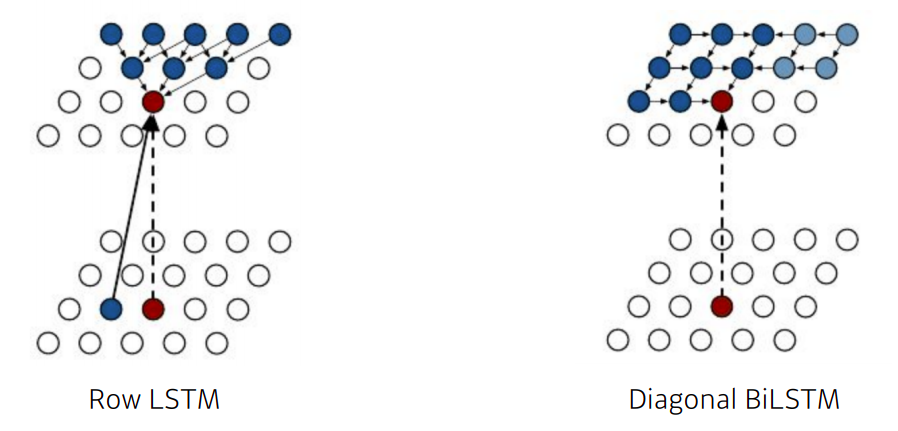[Contents]
1) Generative Models part 1
2) Generative Models part 2
Generative Models part 1
- 머신러닝, 딥러닝에서 의미하는 Generative model이 무엇인지, 이해하기 위한 기본적인 통계 이론, 다양한 Generative model의 수식아이디어, 구조에 대해 설명
What Generative Models can do
- 강아지 사진들이 주어졌을때
- 다음과 같은 확률 분포 를 배우고 싶다
- generation : if we sample should look like a dog(sampling)
- 학습데이터에 있지 않은 강아지와 같은 이미지를 만들어낼 수 있다
- density estimation : should be high if looks like a dog, and low otherwise (anomaly detection)
- 어떤 이미지가 들어왔을때 이 이미지가 강아지 같을수록 확률값이 높다
- 마치 분류 모델같다. Also known as, explicit model
- explicit model : 어떤 입력이 주어졌을때 이 입력에 대한 확률값을 얻어낼수 있는 모델
- implicit model : 단순히 generate 만 하는 모델
- 따라서 엄밀히 말하면 generative model은 분류모델을 포함하고 있다
- unsupervised representation learning : we should be able to learn what these images have in common, e.g., ears, tail, etc (feature learning)
- generation : if we sample should look like a dog(sampling)
- 그렇다면, 는 어떻게 만들수 있을까?
- 이를 알기 위해선 확률의 아주 간단한 기본 지식이 필요하다
Basic Discrete Distributions
- Bernoulli distribution(베르누이) :
- = {Heads, Tails}
- specify , then
- 확률론과 통계학에서 매 시행마다 오직 두 가지의 가능한 결과만 일어난다고 할 때,
- 각 시행에서 성공의 결과가 나타날 확률은 로 나타내며, 실패가 나타날 확률을 로 나타낸다
- 그리고 이 된다
- Categorical distribution :
- = {1,...,m}
- specify such that
- 예) 6개의 주사위를 던지는데 몇개의 parameter가 필요할까?
- n-1 즉 5개의 parameter가 필요하다
- 왜냐하면 나머지 5개의 파라미터가 있으면 마지막 하나는 1에서 다 빼주면 된다
- example
- modeling an RGB joint distribution (of a single pixel)
- number of cases?
- 256 x 256 x 256
- how many parameters do we need to specify?
- 255 x 255 x 255
- 하나의 RGB 픽셀을 fully describe 하기위해서 필요한 파라미터의 숫자는 엄청 많다
- modeling an RGB joint distribution (of a single pixel)
- example 2
- suppose we have of n binary pixels (a binary image)
- how many possible states? (경우의 수)
- 2 x 2 x ... x 2 =
- how many parameters to specify ?
- - 1
- 파라미터의 숫자가 많을수록 학습은 어렵기 때문에 파라미터의 숫자를 줄이기 위해 n개의 픽셀들이 모두 독릭접이라고 가정해본다
- 파라미터 : 확률을 표현하는데 필요한 변수의 갯수
Structure Through Independence
- n 개의 픽셀이 독립적이라면
- possible state(경우의 수)는 으로 같다
- 모든 픽셀이 0 또는 1을 가질 수 있기 때문에 n개의 픽셀이면 이다
- distribution을 표현하기 위해서 필요한 파라미터의 수는 n 개만 있으면 된다
- 각각의 픽셀에 대해서 파라미터 한개만 있으면 되고 n개가 모두 독립적으로 있기 때문에 다 더하기만 하면 된다
- possible state(경우의 수)는 으로 같다
- entries can be described by just n numbers. But this independence assumption is too strong to model useful distributions
Conditional Independence
- fully dependent하면 너무 많은 파라미터가 필요하고
- 이를 독립적으로 가정하면 파라미터의 숫자가 많이 줄어들어서 좋은데 표현할수 있는 이미지가 너무 적다
- 그렇기 때문에 중간지점을 타협하기 위해 3가지 중요한 규칙이 필요하다
- Three important rules
- Chain rule :
- Bayes' Rule :
- =
- conditional independence :
if , then- z 가 주어졌을때 x 와 y 가 독립적이다
- x and y are conditionally indepedent when given z
- conditional indepedence 와 chain rule을 섞어서 fully depedence 모델과 fully independent 모델 사이의 타협되는 모델을 만든다
- Chain rule :
- markov assumption
- how many parameters?
- 2n - 1
- hence, by leveraging the Markov assumption, we get exponential reduction on the # of parameters
- Auto-regressive model leverage this conditional independency
Auto-regressive model
- suppose we have 28 x 28 binary pixels
- our goal is to learn over {0, 1}
- how can we parametrize ?
- let's use the chain rule to factor the joint distribution
- this is called an autoregressive model
- autoregressive model 은 어떤 하나의 정보가 이전 정보들의 dependent하다는걸 말한다
- markov assumption 을 통해서 i번째 픽셀이 i-1 번째 픽셀에만 dependent 한것도 autoregressive 모델 이지만
- i 번째 픽셀이 1부터 i-1번째 픽셀에 모든 정보들에 dependent 한것도 autoregressive model이다
- note that we need an ordering of all random variables
- 순서를 매겨야하기 때문이다
- 이미지에 순서를 매긴다는 것은 명확하지 않다 왜냐하면 이미지는 2차원 공간인데 순서는 1차원 줄이기 때문이다
- 그렇기 때문에 이미지는 다양한 방법으로 순서를 매길수가 있다
- 그리고 순서를 매기는 방법에 따라서 성능이 달라질 수가 있다
NADE : Neural Autoregressive Density Estimator

- the probability distribution of i-th pixel is
- where
- i번째 픽셀을 첫번째부터 i-1번째 픽셀에 dependent 하게 한다
- neural network 입장에서는 입력차원이 계속 변한다
- 그래서 weight가 계속 커진다
- 즉 3번째 픽셀에 대한 확률분포를 만들때는 1번째와 2번째 총 2개의 입력을 받는 weight가 필요한 반면
- 100번째 필섹에 대한 확률분포를 만들때는 99개의 입력을 받는 weight가 필요하다
- NADE is an explicit model that can compute the density of the given inputs
- 단순히 generate만할 수 있는 것이 아니라 임의의 784개의 binary vector가 주어지면 이에 대한 확률을 계산할 수 있다
- how can we compute the density of the given images?
- suppose we have a binary image with 784 binary pixels, {}
- then, the joint probability is computed by
- where each conditional probability is computed independently
- In case of modeling continuous random variables, a mixture of Gaussian can be used
pixel RNN
- we can also use RNNS to define an auto-regressive model
- for example, for an n x n RGB images,
- : Prob. i-th R
- : Prob. i-th G
- : Prob. i-th B
- There are two model architectures in Pixel RNN based on the ordering of chain:
- Row LSTM : i번째 픽셀을 만들때 위쪽에 있는 정보를 활용
- Diagonal BiLSTM : bidirectional LSTM을 활용하되 자기 이전 정보들을 다 활용

Key Takeaways
- Generative model은 단순히 무언가를 생성하는 implicit model 뿐만 아니라 입력에 대한 확률값을 출력하는 explicit model도 있다
- 파라미터 숫자를 통해서 fully independent model, fully dependent model 그리고 conditional independence + chain rule을 활용해서 auto-regressive model 을 알아봤다
Generative Models part 2
- Generative models part 2 에서는 실제로 많이 다뤄지는 Practical 한 Generative model인 Variational Auto Encoder와 Generative Adversarial Network 를 이용하여 Latent variable model 에 대해 설명

